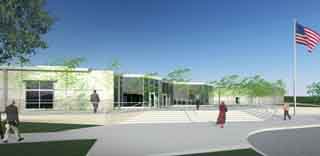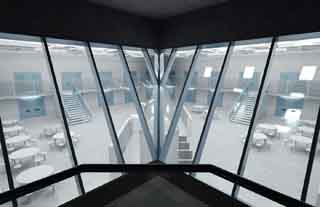|
Subscribe / Renew |
|
|
Contact Us |
|
| ► Subscribe to our Free Weekly Newsletter | |
| home | Welcome, sign in or click here to subscribe. | login |
Construction
| |

December 10, 2009
Seven cities build jail for half the price
Journal Staff Reporter
THE LARGE REGIONAL jail that is rising under the flight path of Sea-Tac Airport is generating a lot of buzz among correctional officials from across the country.
The reason is cost. At about $61,500 per bed, the construction cost is half of what it is for other jails planned in the Northwest, according to DLR Group, which designed the 802-bed facility in Des Moines.
As the recession further stretches governmental budgets, per-bed figures like this will focus a lot of attention on the South Correctional Entity, or SCORE jail. “I think you are going to see this design used again and again,” says Hans Hansen of Lydig Construction, the jail's general contractor.
The attention is already happening, even though construction began only last month and won't be done until the summer of 2011. Entities, both regionally and beyond, are contacting SCORE to find out “how we have been able to pull this together,” says SCORE Interim Director Penny Bartley.
The total cost of the 164,000-square-foot project is $91 million, according to Bartley, with construction totaling about $49.3 million, excluding sales tax.
Space is key
Several factors are contributing to the reduced cost of the facility on nearly 16 acres at the corner of South 200th Street and 18th Avenue South, but the main driver is space efficiency, says architect Bill Buursma, DLR Group principal.
“A room is a room. We can't change that,” he says. But what the project team can control is the layout of that space. “You have to make sure there isn't a lot of unnecessary space, or scope creep.”
Particular attention was paid to circulation patterns and the configuration of the two main housing units, each with seven pie-shaped day rooms with cells off one side. “Because of the layout, we conserve space,” Buursma says. The jail's average per bed space is about 210 square feet. In other facilities, the proportion might be 50 to 100 percent higher, the architect adds.
He expects this configuration also will help reduce the jail's operational costs. A podium with a control room rises in the middle of each of the two general housing units, providing a 360-degree view for guards, who can remotely operate doors and locks. This allows the jail to rely on supervision by fewer guards, though some additional corrections officers will be needed to do bed checks at night. “This still results in much less staff during the slow periods,” Buursma says.
Several other factors, including the down economy, are contributing to the reduced cost, says Buursma and Hansen.
Instead of building thick concrete cell walls, the SCORE jail is using prefabricated steel detention panels that are 2 inches thick and filled with concrete grout. Minnesota-based Trussbilt makes the panels. The one-story configuration with a mezzanine also helped. And by using permeable asphalt, the SCORE jail's stormwater detention facility is smaller.
Hansen thinks having precast walls will reduce the cost of that part of the project by 10 percent. “The real kicker is the walls would have been cast on site in the wintertime,” he says, and that would have required freeze blankets and other equipment. In this cold weather “it would have been a nightmare.”
In putting together its construction bid, Hansen says Lydig was able to capitalize on the fact that it had completed a 540-bed expansion at the nearby Northwest Detention Center in Tacoma. That allowed the company to build on the ongoing, strong relationship with project subs.
Having such communication lines in place was key. Clear, concise communication is the top trait for such projects. “It really helps eliminate assumptions,” Hansen says.
Buursma credits design input from the seven cities — Auburn, Burien, Des Moines, Federal Way, Renton, SeaTac and Tukwila — for also holding down costs. Municipal officials encouraged the use of arraignments and prisoners using video, and reheating pre-made food bought in bulk. This reduces the space needs for these functions as well as operational costs.
“This has been such a nice project for us because we had forward-thinking clients,” Buursma says.
Inexpensive, not cheap
Buursma adds that while the jail is less expensive than comparable facilities, it is not cheap. “You can't have it just be cheap,” he says, noting the SCORE jail will meet or beat health and safety regulations.
The jail, for instance, has a medical unit you'd see in a 2,000-bed prison. The design team increased the size of the intake area so staff will be able to spend more time on classifying what units prisoners should be held in. Better classification helps head off problems later. Buursma says the project did not scrimp on landscaping, which Aspen Design of Issaquah designed.
DLR did the structural and electrical engineering, along with the interior design. KPFF is the civil engineer, and Glumac is the mechanical engineer.
Scarsella Brothers did the site grading and some utility work at a cost of $995,000, excluding sales tax, Bartley says. When construction begins to wrap up, the SCORE project will bid out work to improve intersections and make other access improvements. Bartley is unsure when the work will be bid. “The soonest would be sometime next summer.”
One thing the project did cut out was going through the LEED certification process. With its steel cells made of recycled materials, white reflective roof, stormwater swales, an HVAC system that reclaims heat, bicycle racks and other such features, Buursma thinks the project could have made LEED silver.
“(The seven cities) didn't want to make that something to crow about,” says Buursma.
The cities decided to build and operate the jail because King County decided it will no longer provide misdemeanor jail beds. Cities across the county formed a jail advisory group to coordinate the use of jails and develop a long-term plan to house prisoners. A study showed that the south county cities could reduce their costs if they jointly built and operated a jail. The cities agreed to form a public development authority to undertake the project.
Other King County cities are watching the progress on the SCORE jail. A group similar to SCORE, called NEC, has been formed to address the misdemeanor jail needs for the city of Seattle and other north and east King County cities, including Bellevue, Redmond, Kirkland and Shoreline.
The project's environmental review process is under way. The draft environmental impact statement is to be issued around Feb. 1, with the final EIS coming out this summer. Details of the project are at necmunicipaljail.org.
Previous columns:
- Centex switches gears, builds ‘opportunistically', 12-03-2009
- NW contractors cope with the slow economy, 11-19-2009
- 'Vertical' windmill turns heads in the Northwest, 11-12-2009
- Make sure to follow new rules on stimulus jobs, 11-05-2009
- Contractor adapts to the tough economy, 10-29-2009
- Make sure to E-Verify on federal contracts, 10-22-2009
- After a dozen years, SR 519 comes together, 10-15-2009
- Construction firm owners: Are you ready to retire?, 10-08-2009




